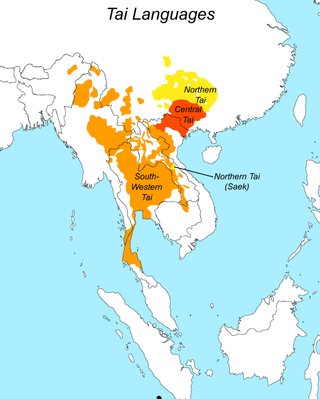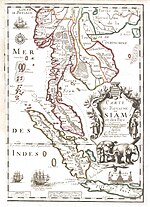
Evidence for modern human presence in the northern and central highlands of Indochina, that constitute the territories of the modern Laotian nation-state dates back to the Lower Paleolithic. These earliest human migrants are Australo-Melanesians—associated with the Hoabinhian culture—and have populated the highlands and the interior, less accessible regions of Laos and all of South-east Asia to this day. The subsequent Austroasiatic and Austronesian marine migration waves affected landlocked Laos only marginally and direct Chinese and Indian cultural contact had a greater impact on the country.

The Tai ethnic group migrated into mainland Southeast Asia over a period of centuries. The word Siam may have originated from Pali or Sanskrit श्याम or Mon ရာမည, probably the same root as Shan and Ahom. Xianluo was the Chinese name for Ayutthaya Kingdom, merged from Suphannaphum city state centered in modern-day Suphan Buri and Lavo city state centered in modern-day Lop Buri. To the Thai, the name has mostly been Mueang Thai.

The history of Southeast Asia covers the people of Southeast Asia from prehistory to the present in two distinct sub-regions: Mainland Southeast Asia and Maritime Southeast Asia. Mainland Southeast Asia comprises Cambodia, Laos, Myanmar, Peninsular Malaysia, Thailand and Vietnam whereas Maritime Southeast Asia comprises Brunei, Cocos (Keeling) Islands, Christmas Island, East Malaysia, East Timor, Indonesia, Philippines and Singapore.

The Mon are an ethnic group who inhabit Lower Myanmar's Mon State, Kayin State, Kayah State, Tanintharyi Region, Bago Region, the Irrawaddy Delta, and several areas in Thailand. There are also small numbers of Mon people in West Garo Hills, calling themselves Man or Mann, who also came from Myanmar to Assam, ultimately residing in Garo Hills. The native language is Mon, which belongs to the Monic branch of the Mon-Khmer language family and shares a common origin with the Nyah Kur language, which is spoken by the people of the same name that live in Northeastern Thailand. A number of languages in Mainland Southeast Asia are influenced by the Mon language, which is also in turn influenced by those languages.

The Lao people are a Tai ethnic group native to Southeast Asia, who speak the eponymous language of the Kra–Dai languages. They are the majority ethnic group of Laos, making up 53.2% of the total population. The majority of Lao people adhere to Theravada Buddhism. They are closely related to other Tai people, especially with the Isan people, who are also speakers of Lao language, but native to neighboring Thailand.

Funan was the name given by Chinese cartographers, geographers and writers to an ancient Indianized state—or, rather a loose network of states (Mandala)—located in mainland Southeast Asia centered on the Mekong Delta that existed from the first to sixth century CE. The name is found in Chinese historical texts describing the kingdom, and the most extensive descriptions are largely based on the report of two Chinese diplomats, Kang Tai and Zhu Ying, representing the Eastern Wu dynasty who sojourned in Funan in the mid-3rd century CE.
The early history of Cambodia follows the prehistoric and protohistoric development of Cambodia as a country in mainland Southeast Asia. Thanks to archaeological work carried out since 2009 this can now be traced back to the Neolithic period. As excavation sites have become more numerous and modern dating methods are applied, settlement traces of all stages of human civil development from neolithic hunter-gatherer groups to organized preliterate societies are documented in the region.

The Dvaravati was an ancient Mon kingdom from the 7th century to the 11th century that was located in the region now known as central Thailand. It was described by the Chinese pilgrim in the middle of the 7th century as a Buddhist kingdom named "To-lo-po-ti" situated to the west of Isanapura (Cambodia) and to the east of Sri Ksetra (Burma). Dvaravati also refers to a culture, an art style, and a disparate conglomeration of principalities of Mon people. Archaeological research over the past two decades or so has revealed the presence of a "Proto-Dvaravati" period which spans the 4th to 5th centuries, and perhaps earlier.
Suvarṇabhūmi is a toponym, that appears in many ancient Indian literary sources and Buddhist texts such as the Mahavamsa, some stories of the Jataka tales, the Milinda Panha and the Ramayana.

Chenla or Zhenla is the Chinese designation for the successor polity of the kingdom of Funan preceding the Khmer Empire that existed from around the late sixth to the early ninth century in Indochina. The name was still used in the 13th century by the Chinese envoy Zhou Daguan, author of The Customs of Cambodia. It appears on the Mao Kun map. However, modern historiography applies the name exclusively to the period from the late 6th to the early ninth century. This period is also known as Pre-Angkorian. It is dubious if "Chenla" ever existed as a unitary kingdom or if this is a misconception by Chinese chronists. Most modern historians assert that "Chenla" was in fact just a series of loose and temporary confederations of principalities.

The known early history of Thailand begins with the earliest major archaeological site at Ban Chiang. Dating of artifacts from this site is controversial, but there is a consensus that at least by 3600 BCE, inhabitants had developed bronze tools and had begun to cultivate wet rice, providing the impetus for social and political organisation.
The Khmer people are a Southeast Asian ethnic group native to Cambodia. They comprise over 90% of Cambodia's population of 17 million. They speak the Khmer language, which is part of the larger Austroasiatic-language family found in parts of Southeast Asia, parts of central, eastern, and northeastern India, parts of Bangladesh in South Asia, in parts of Southern China and numerous islands in the Indian Ocean.

Greater India, or the Indian cultural sphere, is an area composed of many countries and regions in South and Southeast Asia that were historically influenced by Indian culture, which itself formed from the various distinct indigenous cultures of these regions. Specifically Southeast Asian influence on early India had lasting impacts on the formation of Hinduism and Indian mythology. Hinduism itself formed from various distinct folk religions, which merged during the Vedic period and following periods. The term Greater India as a reference to the Indian cultural sphere was popularised by a network of Bengali scholars in the 1920s. It is an umbrella term encompassing the Indian subcontinent, and surrounding countries which are culturally linked through a diverse cultural cline. These countries have been transformed to varying degrees by the acceptance and induction of cultural and institutional elements from each other. Since around 500 BCE, Asia's expanding land and maritime trade had resulted in prolonged socio-economic and cultural stimulation and diffusion of Hindu and Buddhist beliefs into the region's cosmology, in particular in Southeast Asia and Sri Lanka. In Central Asia, transmission of ideas were predominantly of a religious nature. The spread of Islam significantly altered the course of the history of Greater India.

The largest of the ethnic groups in Cambodia are the Khmer, who comprise approximately 90% of the total population and primarily inhabit the lowland Mekong subregion and the central plains. The Khmer historically have lived near the lower Mekong River in a contiguous arc that runs from the southern Khorat Plateau where modern-day Thailand, Laos and Cambodia meet in the northeast, stretching southwest through the lands surrounding Tonle Sap lake to the Cardamom Mountains, then continues back southeast to the mouth of the Mekong River in southeastern Vietnam.

The peopling of Thailand refers to the process by which the ethnic groups that comprise the population of present-day Thailand came to inhabit the region.

The Lavo Kingdom was a political entity (mandala) on the left bank of the Chao Phraya River in the Upper Chao Phraya valley from the end of Dvaravati civilization, in the 7th century, until 1388. The original center of Lavo civilization was Lavo, but the capital shifted southward to Ayodhaya, the port city on the right side of the Ayutthaya island around the 11th century, whereupon the state was incorporated into the Ayutthaya Kingdom in the 14th century.

Sbai or phaa biang is a shawl-like garment or breast cloth worn in mainland Southeast Asia. Sbai is worn by women as a silk breast wrapper in Cambodia, Laos, and Thailand, while in coastal Sumatra and Malay peninsula, the same term is used to describe a shoulder cloth. The sbai was derived from the Indian sari, the end of which is worn over one shoulder.

Tai peoples are the populations who speak the Tai languages. There are a total of about 93 million people of Tai ancestry worldwide, with the largest ethnic groups being Dai, Thais, Isan, Tai Yai (Shan), Lao, Tai Ahom, and Northern Thai peoples.

The Mon–Burmese script (မွန်မြန်မာအက္ခရာ)(listen Mon: အက္ခရ်မန်ဗၟာ) is an abugida that derives from the Pallava Grantha script of southern India and later of Southeast Asia. It is the basis of the alphabets used for modern Burmese, Mon, Shan, Rakhine, Jingpho and Karen.
The Camadevivamsa is a Pali chronicle composed in the early 15th century by the Lanna Buddhist monk Mahathera Bodhiramsi. The chronicle, dated to c. 1410, is a semi-historical recounting of the founding of the Mon Dvaravati kingdom of Hariphunchai (Haripunjaya) in the mid-sixth century by Queen Cāmadevi and her establishment of a lineage destined to rule Haripunchai for the next 500 years. The manuscript ends with King Adittaraja's discovery of a sacred relic of the Buddha in the eleventh century that became central to the Theravada Buddhist culture of Haripunchai and is still enshrined in Wat Phradhatu Haripunjaya in present-day Lamphun, Thailand. In addition to the Camadevivamsa, which is also known in English as The Legend of Queen Cama and The Chamadevivongs, Bodhiramsi also composed, in 1417, the Tamnan Phraphutthasihing, another chronicle which describes the history of the Phra Phuttha Sihing image, from its creation in Ceylon to its enshrinement in 1411 at Chiang Mai, the capital of Lanna.













